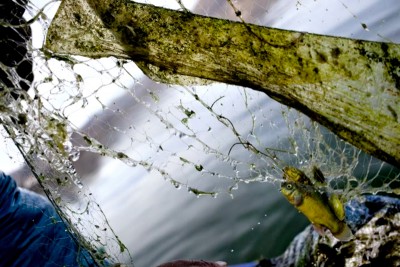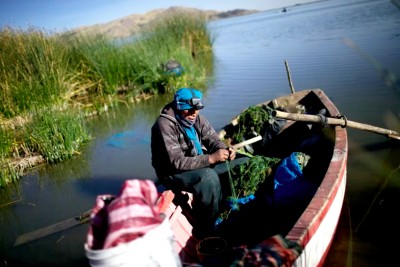
Marcelino Coila Choque is from a family of fishermen in Peru. From his small village along Lake Titicaca, he has watched the water turn opaque with pollution from the expanding city of Puno.
Radio journalist Sara Shahriari and Photojournalist Noah Friedman-Rudovsky follow Coila Choque on his morning fishing rounds in an audio slideshow.
[youtube=http://youtu.be/KblBdq62ZAs&w=560&h=315]
EL ALTO, Bolivia–Thousands of indigenous people live along the shores of Lake Titicaca in Bolivia and Peru and their family practices are becoming more at risk with growing pollution.
The world’s highest navigable lake has long provided these communities with a subsistence living—primarily fishing and basic agriculture. But in recent years, some communities have struggled as pollution begins to endanger their livelihoods.

The population in the Lake Titicaca watershed is rising quickly, particularly in several key cities, as residents of the region’s vast high plains seek education and steady employment away from their isolated rural homes.
The largest of those cities is El Alto, Bolivia. As it grows, the waste El Alto produces, including trash and sewage, increases and now fills riverbeds that carry contamination downstream to the lake.
Fishermen are not the only ones taking a hit from the pollution. Farmers can no longer allow their cattle to drink from rivers that feed Lake Titicaca and they fear lake water will contaminate their crops.
The lake is large and much of it is still clean, but without steps to control water pollution these effects will spread.

According to a 2012 synopsis by the United Nations Environment Program, issues including sewage discharge, pollution from uncontrolled development and illegal mining demand solutions in the Lake Titicaca watershed.
We followed the path of contamination, first investigating the sources of pollution in urban areas and the rural to urban migration that drives cities’ growth. We then traveled along the shore of Lake Titicaca, visiting affected communities and documenting the changes in their lives.
During one of these trips on the Peruvian side of the lake, we met an Aymara Indian fisherman, Marcelino Coila Choque, who lives in a village on the lakeshore near Puno, Peru.
Puno is the largest city located directly on Titicaca’s shores and also struggles to manage wastewater.
“Pollution is advancing through the lake,” Coila Choque said. “All the pollution that comes from the cities, sometimes even people from my town leave trash and plastic around. It makes our lake sick.”
Coila Choque was anxious to tell us about how the waters he fishes have changed, and took us out early one morning to show us how he lives, and how his life has been affected.
Reporting for this story was completed with a grant from the Pulitzer Center on Crisis Reporting
[ts_fab authorid=”57″ tabs=”bio,twitter,facebook,googleplus,latest_posts”]


1 Comment
Comments are closed.